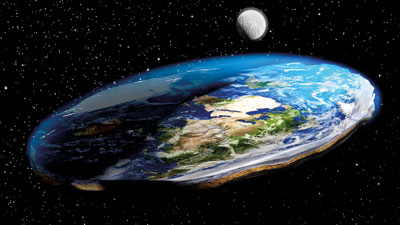Sunday Times 2
What if the Earth was flat?

The Earth is a sphere. This is a simple fact that humans have known for thousands of years; it was incontrovertibly confirmed as soon as the Soviet Union launched the Sputnik 1 satellite in 1957 and it went … you know … around the globe.
Nevertheless, a small but vocal group of people who insist that the world is flat — so-called flat-Earthers — have emerged online in recent years, and they seem to be sowing doubt about this most basic aspect of reality. Many flat-Earthers put a great deal of effort into concocting alternative explanations for why the world behaves as if it’s round when it’s actually flat — even though a spherical Earth clearly fits the observations humans have made about the planet over the last few millennia.
However, if Earth, somehow, were truly flat, it would not behave much like the planet we know today. In fact, humanity (and everything else) would be very, very dead.
To shape a cosmic body into a disk (rather than a sphere), you’ve got to spin it very fast, says David Stevenson, a planetary scientist at Caltech in Pasadena, California. This would, unfortunately, destroy the planet by tearing it into tiny particles. In the 1850s, astronomer James Clerk Maxwell showed mathematically that a solid, disk-like shape isn’t a stable configuration in the cosmos, in work he conducted regarding Saturn’s rings.
Maxwell’s research predicted that Saturn’s rings would be made of lots of small, unconnected particles; he turned out to be right. His math also explains why there are no planet-size disks floating around the galaxy.
To flatten Earth without spinning it very rapidly, you’d need magic, or perhaps a galactic panini press. At any rate, a stamped-flat Earth wouldn’t last for long. Within a few hours, the force of gravity would press the planet back into a spheroid. Gravity pulls equally from all sides, which explains why planets are spheres (or nearly so – depending on the speed of a planet’s rotation, those forces may work against gravity to create a bit of a bulge at the equator). A stable, solid disk-like Earth just isn’t possible under the actual conditions of gravity, as Maxwell’s math showed.
And once you get rid of gravity, everything about our planet rapidly stops making sense.
The atmosphere? Gone, because it’s held to the planet by gravity. Tides? Gone. They’re caused by the gravitational pull of the moon, which tugs on the oceans and causes them to subtly bulge out as it swings by.
The moon itself? Also gone, since every explanation of the moon’s existence involves gravity. In the most widely accepted scenario, the moon was created when a giant, planet-size body crashed into the early Earth; debris from the crash was captured by Earth’s gravity. Another scenario suggests that the moon formed at the same time as Earth did (again, thanks to gravity). Or, Earth’s formidable gravity attracted and snagged the travelling hunk of space rock as it went hurtling by.
Simple calculations
Gravity is also responsible for Earth’s layered structure, with the densest materials sinking to the core, lighter materials making up the mantle and the lightest materials forming the crust. Without this layered structure, the planet would behave a lot differently.
Earth’s liquid outer core, for example, acts as a giant, dynamic magnet, which creates the planet’s magnetic field. The magnetic field helps protect the planet’s atmosphere from the stripping effect of the solar wind, which scraped away Mars’ atmosphere after that planet’s magnetic field faltered 4 billion years ago. If the Earth were flat, plate tectonics — the movement of rigid plates that make up the planet’s crust — wouldn’t work either, says James Davis, a geophysicist at the Columbia University Lamont-Doherty Earth Observatory in New York City.
“When you do the calculations, just simple calculations like, ‘If this plate is moving this much and that plate is moving that much,’ you have to do it on a sphere,” he told Live Science. “You don’t get the right answer [the answer that matches real-world observations] if you assume it’s a plane.”
Flat-Earthers spin different explanations for how all these observations could be possible on a flat planet. The problem, Davis says, is that these explanations don’t have any basis in mathematics or physical reality. When Maxwell predicted in the 1850s that Saturn’s rings were made of lots of small particles, he did so by applying general knowledge of how gravity and rotational forces work. His essay on the subject, in fact, was mostly mathematical equations. Flat-Earth theories don’t work that way, Davis says.
The flat-Earth worldview also involves cherry-picking different explanations for different phenomena. In real life, the Earth and the Moon are both round for the same quantifiable reason — gravity. Flat-Earth believers have to invent independent explanations for both, and these independent explanations often contradict one another. This isn’t how scientific theory works, Davis says.
“If we can explain a thousand observations with one theory, a simple theory, that’s better than explaining a thousand observations with a thousand theories,” he said.
But setting all that aside, if the Earth was truly flat, it would mean that the millions of scientists who deny its flatness — and who have done so throughout history — are united in a vast conspiracy for reasons that are flat-out unfathomable. It almost makes the prospect of a galactic panini press look realistic.
Courtesy livescience.com

